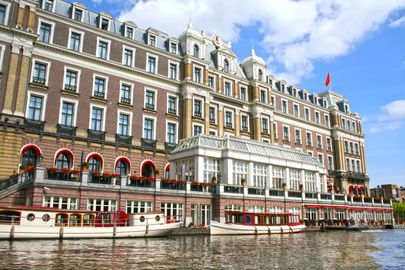

This illustrious Amsterdam landmark majestically reposes along the bank of the Amstel River and has welcomed guests since 1867. Envisioned by the city's great visionary, Dr Sarphati, Amstel Hotel was the first grand hotel to be established in Amsterdam. Before that time, the city was unable to provide accommodation that lived up to international standards and such allure. While other major European capitals had already opened grand hotels, Amsterdam could only offer simple guesthouse lodging at the time. Samuel Sarphati, who ran a busy medical practice, was an idealist, who had initiated many projects to help improve the city residents' well-being and hygiene. Moreover, he was a visionary, who wanted to elevate Amsterdam's lagging international in the 19th century status back to being one of the most interesting cities in Europe. Sarphati was also the initiator and the driving force behind the realization of The Industry Palace, an enormous exhibition hall made of glass and steel that resembled the Crystal Palace in London, which unfortunately went up in a conflagration in 1926 and was subsequently never rebuilt. The Dutch National Bank was built at the same location in the 1960s. A park, a street, and a small embankment were named after Sarphati to commemorate his great contribution to the city,
Like many other projects of its kind, Amstel Hotel had many critics. At the time, this location was the outskirts of the city and erecting such a costly project at the periphery was considered absurd. Nonetheless, despite financial difficulties, the project took off and Cornelis Outshoorn became the architect commissioned with drafting the plans. The initial plans were further abridged and of the originally planed four wings, it was decided to build just one. The first stone was laid on April 26th 1866 and further construction went without a hitch. Designing the exterior of the Amstel Hotel, Outshoorn was inspired by the French Renaissance style of the 16th and 17th centuries also employed in the Louvre and in the castles along the Loire. For the outer surface, he mainly used red and yellow brick.
One year later, on April 27th 1867, the hotel was completed. Dr Sarphati, however, died before seeing his brainchild materialize. After its official opening in 1867, the hotel received universal praise. The entrance hall is particularly lavish and features marble, crystal chandeliers, Persian carpets, exquisite furniture, gold leaf and high ceilings. In 1899-1900, another floor was added.
The hotel initially had a slow start, but in 1870 things started to pick up and the hotel began to attract a special kind of clientele. The reason for their visit was Doctor Johann Georg Mezger, a young surgeon who established his practice in the hotel. Mezger treated people from all classes of society and walks of life, though he was renown for operating on royalty and nobility. His patients often chose to stay at the Amstel Hotel. For eighteen years Mezger received his patients at the hotel until deciding to move to Wiesbaden in 1888. Dr. Mezger is credited with being one of the founders of contemporary physiotherapy. Fortunately, after his precipitous departure the number of visitors to the hotel did not decline. Royalty, including the Shah of Persia and the Crown-Princess of Austria, were among the notable guests. Among more recent guests, the Rolling Stones, Rihanna and other stars have been frequent company.
Much of the Amstel Hotel original interior has undergone many changes since its opening, however the entrance hall has remained in its authentic state. In 1990, Amstel Hotel closed down for a major renovation. John Irving, an architect from the United States, was in charge of the renovation. He was assisted by Pierre Yves Rochon who reworked interior and a landscaper Anette de Koning who reconstructed the terrace. When the hotel reopened two years hence, the original 111 rooms have been converted into 79 rooms and suites ranging from Executive rooms to Junior and Executive suites and the Royal Suite. The hotel has 140 employees, which means that every single guest receives personal service. Not only is this a unique concept for the Netherlands, but it also guarantees unparalleled service anywhere in the world.
Today, almost 150 years after opening its doors in 1867, the Amstel Hotel has become synonymous with the very finest in hospitality, making it a favorite destination for celebrities, dignitaries and the royalty. Step into the grand lobby and the effect is both keen and inspiring. A grand Dutch ambience enhanced by soaring archways and twinkling chandeliers extends a truly intimate welcome. The Clefs d'Or concierges greet the guests from the lobby's antique counter. You don't have to be staying at the Amstel hotel to enjoy a high tea or a lunch at the hotel's terrace and appreciate its rich blend of classic elegance and modern luxury. The Amstel Hotel restaurant La Rive, whose chef is Rogér Rassin, is also open to the public and has earned a Michelin star in 2006.